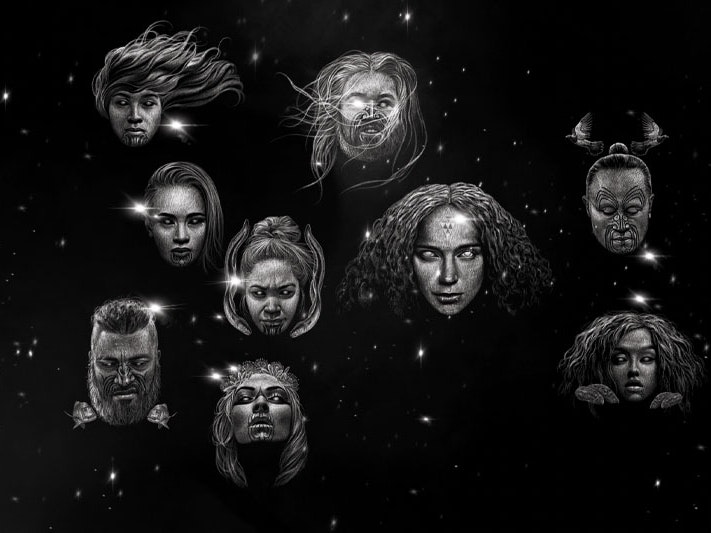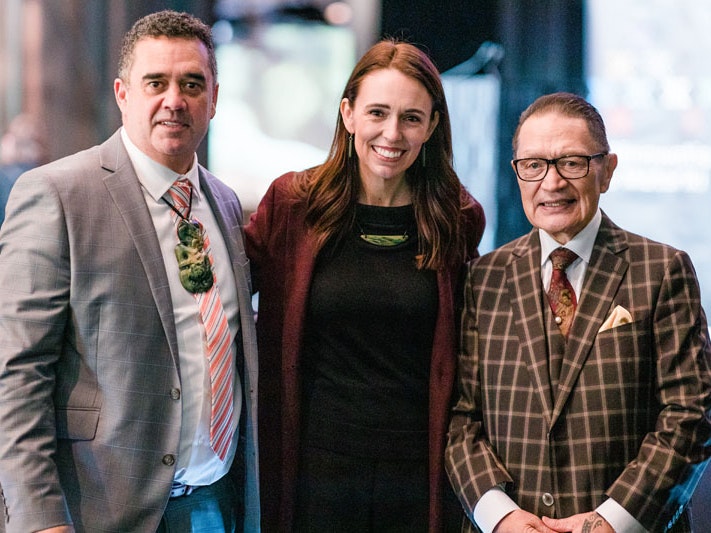
Ngā whetū o Matariki
There are over 500 stars in the Matariki cluster – but only a handful are visible without the use of a telescope. Each of the stars has their own unique characteristics that Māori acknowledge and honour. Meet the stars here!
Free museum entry for New Zealanders and people living in New Zealand
Open every day 10am-6pm
(except Christmas Day)
Free museum entry for New Zealanders and people living in New Zealand
Sonia Snowden (Ngāti Whātua, Ngā Puhi, Ngāti Hine, Ngāti Wai) is a master weaver whose tukutuku panel Matariki is in our collection. This taonga inspired designer Tyrone Ohia (Ngāti Pukenga, Ngāi te Rangi) in his creation of the tohu for the Matariki public holiday.
Here, the two meet up to kōrero on their craft.
Sonia Snowden, Matariki, 2011 kiekie, raupō, kākaho, pīngao. Te Papa (ME024103)
Tyrone: Is the kiekie natural and is the pingao dyed, or...?
Sonia: No it’s natural.
Tyrone: Oh, true.
Sonia: It’s in its natural form. There’s no boiling.
Tyrone: Hika!
Sonia: That’s how it comes.
Tyrone: Kōwhai rawa atu, eh?
Sonia: When it’s picked, it’s green. So you’ve got to leave it out and it turns gold.
Tyrone: Wow! Whaea, what do you call this pattern again?
Sonia: Tumatakahoki.
Tyrone: Tumatakahoki. This is in Rangiātea?
Sonia: Āe, the whole board was in this pattern and all the boards inside Rangiātea. Purapurawhētū. But there was no gaps in the tumatakahoki in Rangiātea. It was very close together like that. It was all up here. I didn’t put it on paper or anything. I just tutu’ed around with the kiekie and that’s what...
Tyrone: Wow. Whaea, were you guys doing anything for Matariki in those days? Was Matariki talked about much?
Sonia: Not really. Only when we started this, and then they were hanging up on the wall.
Tyrone: We always got to start with these sorts of taonga, Whaea. And then, you know, we just ... and it was lucky that there was a really good picture of it online ... on the Te Papa collections.
And so we were talking about that because we had Te Papa in the room with us on our working group and so it made sense that there was a taonga there, you know, and it was about Matariki and those sorts of things and so it was a real talking point for us, eh.
All of us as a rōpū would have this picture up, you know, the photograph of this up and then we’d be thinking about how we can interpret it or, you know, find a way to re-imagine parts of it for the tohu. Yeah.
And we had to do nine because, you know, there’s nine whetū now, so those are the nine whetū, but we tried to take a similar ... Well, you know, we tried to almost acknowledge all of those rules within tukutuku. You know, there’s sort of a ... You’ve got your horizontals, and then you’ve got your sort-of verticals, and you’ve got your overlap, and then under and then over, and then under and over, and again this way, under, over, under ... With the whakaaro that the nine stars are their own individuals with their own kōrero and their own characteristics. But through that weave they’re also kind of connected as a cluster. Yeah.
Sonia: Whereas as these stars here, it’s the top one that’s to the right, always goes to the right, and the left is under.
Tyrone: Marama. One of the other challenges for us was to, make all the stars feel like they’re the same, but different. And that’s when we were looking at this whakaaro here of some being in kiekie and some being in pingao and different colours. The brightest white whetū is Matariki.
Sonia: Whereas this is Matariki, for this. Yeah. Brightness. The brightest.
Tyrone: Yes. You know, we’re still doing the same thing as you, Whaea, when we’re going ‘which is the most important one?’ We had to spend a bit of time on the colours too actually, because you want it to ... you want to know that those are wai-related and this one is whenua-related and rākau-related. So we were kind of going, Waitī being sort-of shallower wai, and then Waitā kind of deeper oceans, and then Waipunarangi up in the air, Ururangi for our winds, and then Hiwa-i-te-Rangi as our potiki, our last star. And so yeah, you can sort-of see how we start by looking at the ways that you kind of differentiate the whetū and then we try and work with that to figure out how to tell those different stories.
Tyrone Ohia and Sonia Snowden in a still from the video, 2023. Te Papa

There are over 500 stars in the Matariki cluster – but only a handful are visible without the use of a telescope. Each of the stars has their own unique characteristics that Māori acknowledge and honour. Meet the stars here!

The Matariki public holiday is based on the winter rising of the Matariki cluster in the early morning sky during the Tangaroa period of the lunar month of Pipiri.